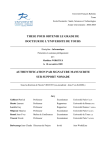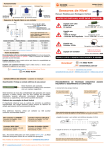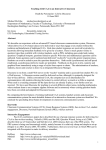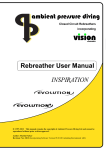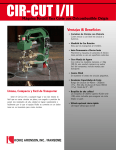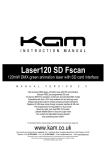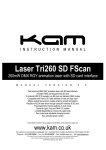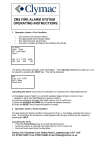Download PUB HS53 Automated link analysis using radio
Transcript
Loughborough University Institutional Repository Automated link analysis using radio frequency identication (RFID) This item was submitted to Loughborough University's Institutional Repository by the/an author. MANSFIELD, N.J. ... et al, 2010. Automated link analysis using radio frequency identication (RFID). IN: Anderson, M. (ed.). Contemporary Ergonomics and Human Factors 2010: Proceedings of the International Conference on Contemporary Ergonomics and Human Factors 2010, Keele, UK. London : Taylor & Francis, pp.293-298. Citation: Additional Information: • This is a conference paper. It was accepted for publication in Conc Taylor & Francis]: temporary Ergonomics and Human Factors 2010 [ http://www.routledge.com/books/details/9780415584463/ Metadata Record: Version: https://dspace.lboro.ac.uk/2134/6438 Accepted for publication Publisher: c Taylor & Francis Please cite the published version. This item was submitted to Loughborough’s Institutional Repository (https://dspace.lboro.ac.uk/) by the author and is made available under the following Creative Commons Licence conditions. For the full text of this licence, please go to: http://creativecommons.org/licenses/by-nc-nd/2.5/ Mansfield NJ., Evans JJ, Andrews C, Lancaster AP, Ransome IR, Moti Z, Li L, Kniveton K, Zhao Y, Hignett S. (2010). Automated Link Analysis Using Radio Frequency Identification (RFID). In Anderson, M. (ed.) Contemporary Ergonomics. London: Taylor & Francis. 293-298 AUTOMATED LINK ANALYSIS USING RADIO FREQUENCY IDENTIFICATION (RFID) N.J.Mansfield, J.J.Evans, C.Andrews, A.P.Lancaster, I.R.Ransome, Z.Moti, L. Li, K.Kniveton, Y.Zhao, SHignett Department of Ergonomics (Human Sciences) Loughborough University Loughborough Leicestershire LE11 3TU UK Being able to accurately record the interactions which take place within any environment is beneficial for understanding human behaviour in a wide range of industries. Link Analysis is a standard technique which is often used, but traditional pen and paper methods are cumbersome and time consuming. This paper details a way to automate recording the interactions between a human and their current environment by using radio frequency identification (RFID) tags and a subject-mounted receiver. Using the results from the system, it is possible to instantly create conventional Link Analysis diagrams and tables, reducing the time and resources required for data collection and analysis. The system has been developed in partnership with the Healthcare Ergonomics and Patient Safety Unit (HEPSU) at Loughborough University, with initial focus being on monitoring paramedics, patients and environment interactions within an ambulance; however, the technologies and the analyser system are not limited to use within this particular field. Introduction Link Analysis (LA) is an established tool to assist in the understanding of dynamic interactions in an environment. In LA, systems are composed of links and elements. Elements comprise items in the system which are drawn in a logical pattern, often representing the physical layout of the system being studied. Links are drawn between elements in order to record the sequence of activity. When a LA is complete, a diagram is produced showing all links between elements, thus providing information on activity patterns. The LA might represent activity for an entire task or for a fixed period of time. If elements have many links between them it indicates that they are often used in close chronological proximity; it might therefore improve efficiency if they are located in close spatial proximity. Thus LA is a valuable tool for optimisation of workplace ergonomics. LA has been used to understand work patterns of healthcare professionals (e.g. Ferreira and Hignett, 2005; Jones et al, 2009). When performing Link Analyses the interactions have been recorded manually, with researchers observing paramedics, in real or simulated emergency situations. The interactions between the patient and the ambulance equipment and consumables were then recorded on paper. This is a labour intensive process where the researchers have to carefully observe the paramedics and try and record every single interaction. This is sometimes augmented by the use of video recording. In a confined environment such as an ambulance, there is limited space for the observer or their cameras, and there could be ethical and privacy issues related to direct observation. It would therefore be beneficial to automate part of the LA procedure such that the observer does not need to be physically present during data collection. This paper describes a development of LA which uses Radio Frequency Identification (RFID) tags to instrument an ambulance and a wrist-mounted RFID detector. This system allows for automated recording of the LA links between the tags (elements). A LabVIEW front end system is utilised as the computer based interface which records the links and automatically draws the LA diagram and produces an interaction matrix instantly. The system is wireless, using Bluetooth technology, thus allowing healthcare professionals minimal disturbance from the system. Principals of RFID The goal of any RFID system is to collect information and data automatically, rapidly and accurately. There are currently no defined standards for the architecture and infrastructure of such systems but there are three main components that are part of RFID systems (Graafstra, 2006): • RFID Tags are placed on objects and can be unobtrusive. They contain at least a chip with a unique identification number and antenna which can be used to identify the host object. Tags can be active (which require constant power) or passive which are powered inductively. • The RFID Reader includes a radio antenna and is capable of at least reading the tag identification number but can sometimes also write data to the tag. Tags and readers must operate at the same radio frequency; the frequency influences the read range (distance between reader and tag to obtain a ‘read’), antenna size and power consumption. • The Data Processing System (Server) collects and processes the data and controls the read/write operations of the RFID Reader. The Server can be integrated with the Reader or can use a wired or wireless data connection. The Server must include data correction algorithms to clean duplicates or mis-reads and to buffer data if multiple tags are in range of the Reader. In order to read a tag the Server commands the RFID Reader to make a read (Figure 1). The RFID Reader then sends a read request. Any RFID Tags within range will respond with their ID number and this number is then relayed to the Server. For an automated system, the Server will request reads at regular intervals (e.g. 10 times per second). Figure 1. Example of RFID system hardware. RFID Link Analysis system overview For the RFID Link Analysis system, the RFID tags are placed on objects which the user intends to monitor. In the system architecture diagram (Figure 2) this is represented by the RFID Tags entity. A Bluetooth RFID reader is mounted on each wrist of up to three subjects (i.e. six readers). If the reader is moved into the readable range of any of the tags, the system is alerted of this event and it is logged into a database. Once the required amount of data have been collected the user can select the desired output from options including raw data tables, link analysis diagrams and basic interaction diagrams. The RFID tags used in the system are passive tags so require no power source. Every tag has a unique identity number which can be read by a reading device. Currently the system utilises lowcost wipe-clean credit card size tags; these are 54 x 85mm and 1mm in thickness. These cards can easily be placed on cupboards, equipment and on test mannequins. Smaller RFID tags are available which could be incorporated into the patient stretcher in order to monitor patient-crew interactions in real-life situations. Each RFID tag has an ideal read range of around 110mm and for large scale items, multiple tags can be used. The software allows for tag clustering where multiple tags represent one element in the LA. This is stored in the RFID Tag Name Database shown in Figure 2. If close to metallic objects, read ranges can be reduced to about 55mm and so care must be taken to ensure appropriate placement or shielding should be used. There is no limit to the number of tags that can be used with the system, therefore complex tag arrays can be constructed providing many more elements than are possible in conventional Link Analysis. Although the tags themselves have a wipe clean surface, are reusable and have an indefinite life, if there are infection control concerns, they can be considered disposable, as each tag only costs around £1.50 and are available off the shelf. Figure 2. System architecture The RFID readers are 40 x 55 x 20 mm and can be fixed into a wrist strap. The readers contain a small rechargeable battery which lasts for around 5 hours. They communicate with the Server through standard Bluetooth technology, as already used in ambulances. Tags must be sited to be in ideal positions relative to the Reader. For example, tags on the handle of a cupboard door should be mounted beneath the handle such that they are within the read range of the wristmounted reader while the door is being opened. RFID Link Analysis data analysis The LA software must be programmed to incorporate each tag and reader. The software uses an image as a background for the data analysis (Figure 3). Each tag is programmed into the system by scanning with the reader to obtain the tag ID at which time the user is prompted to select a location for the tag on the image. The current system records each read in a data file. If a user maintains their position close to a tag then the tag will be read at each read request which occurs 10 times per second. In the data analysis phase, the raw data file is cleaned to remove duplicate reads and leaves a results file recording the time of read-start and read-end for each link. This allows for a traditional LA diagram or interaction matrix to be drawn but with additional information such as the direction of the link and the precise timing of interactions. The two main benefits of the RFID Link Analysis system are the speed of obtaining results and the possibility of monitoring up to six Readers simultaneously. The data analysis phase of the LA process is very rapid. One hour of observational data takes about two minutes to analyse and to produce the final Link Diagram using a basic laptop computer. Quicker processing can be achieved on more powerful computers. Figure 3. Example basic LA output showing location of four tags, links between each tag and diagrammatic representation of ambulance interior. The output can be saved as a graphic image or as a data file. These files can include results for the complete data set or subsets for each subject Future development Although this system has been developed within the healthcare environment, it will be generally applicable to many work environments. Furthermore, the reduction of the need for the observer to be physically present in the workspace has potential benefits in terms of privacy and space restrictions. Readers could be mounted on ankles instead of wrists. This would mean that the position of a worker could be tracked via tags mounted into the floor of a workspace and a reader mounted onto their ankle. It would be feasible to manufacture a floor covering incorporating a large array of tags which could be installed into a test facility. This would allow for movement to be monitored in terms of body position rather than interaction with elements. The current limit of six readers is a design limitation to ensure that the level of complexity in the analysis was manageable. If additional data are required, this could be achieved using a second array of readers paired with a second Server and PC whilst still using the same array of RFID tags. With this approach, the number of subjects being observed may be unlimited. To date the system has reached full Beta test stage and includes hardware, software and data analysis packages, and a user manual. It has been used by novice users and LA experts. It has been used and demonstrated functioning in an ambulance under controlled laboratory conditions. Further research is needed to verify that it is reliable under full field test conditions. RFID technologies could be implemented in different ways to perform LA and other data collections tasks in the field of ergonomics. Summary Historically human interaction monitoring using Link Analysis has taken place using direct observation or some method of video capture; videoing a scenario from multiple angles and focusing on the direct monitoring of the people and their behaviour. The new RFID method takes longer to set-up than the traditional pen and paper method, but analysis is almost instantaneous. The level of detail which the system provides is far greater than that obtained using the traditional method in both detail and breadth, and the simplicity and speed of the system offers new possibilities to the field of human activity monitoring. References Graafstra, A. 2006, RFID Toys, First Edition (Wiley Press, UK) Ferreira J. and Hignett S.M. 2005, Reviewing ambulance design for clinical efficiency and paramedic safety, Applied Ergonomics, 36, 97-105. Jones, A., Hignett, S., Benger, J. (2009) Mobile Pods: Technology to Support the Delivery of th Community-Based Urgent Care. Proceedings of the 17 Triennial Congress of the International Ergonomics Association Beijing, China, 9-14 August 2009









